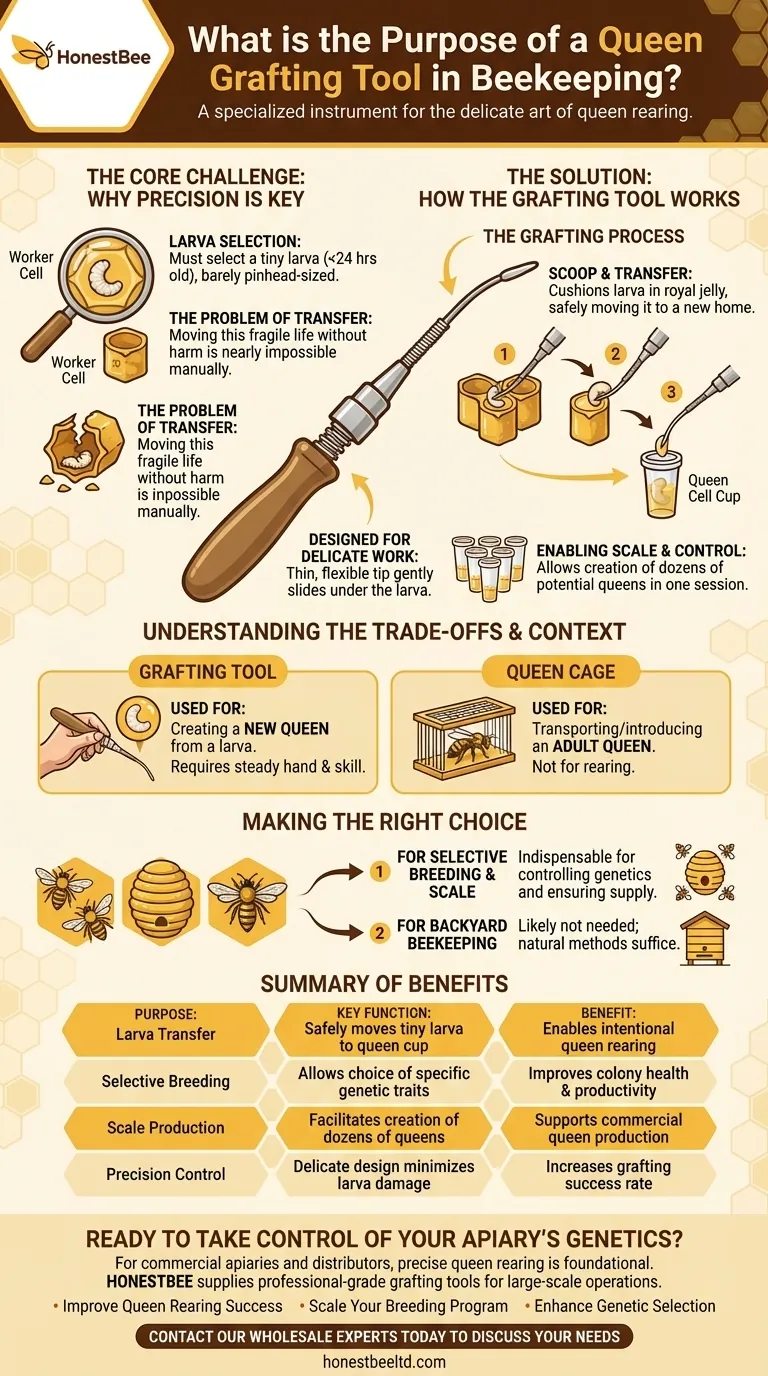A queen grafting tool is a specialized instrument used by beekeepers to manually transfer a single, tiny honey bee larva from a worker cell into an artificial queen cell cup. This delicate procedure is the foundational step in the process of rearing new queen bees.
The core purpose of a queen grafting tool is to give a beekeeper precise control over the most delicate part of queen rearing. It solves the fundamental challenge of moving a nearly microscopic larva without causing harm, enabling the intentional breeding of queens with desirable traits.

The Core Challenge: Why Queen Rearing Demands Precision
What is Queen Rearing?
Queen rearing is the practice of intentionally raising new queen bees rather than purchasing them or letting a colony raise them naturally.
This process allows beekeepers to select for and propagate specific genetic traits. They can breed from colonies that demonstrate mite resistance, high honey production, or a gentle temperament.
The Critical First Step: Larva Selection
The success of queen rearing hinges on selecting a larva that is less than 24 hours old. At this stage, it is barely larger than a pinhead.
This young larva still has the potential to develop into a queen if it is moved to a special cell and fed royal jelly by the worker bees.
The Problem of Transfer
Moving something so small and fragile from the base of a wax cell is nearly impossible without a specialized tool. The larva can easily be damaged or destroyed, ending the attempt before it begins.
This is the specific problem the grafting tool is designed to solve.
How the Grafting Tool Solves the Problem
Designed for Delicate Work
A grafting tool typically features a very thin, flexible, and sometimes spring-loaded tip. This design allows the beekeeper to gently slide the instrument underneath the larva's C-shaped body.
The goal is to scoop up the larva along with a small amount of the royal jelly it is floating in, cushioning it for the transfer.
The Grafting Process
The beekeeper carefully slides the tool's tip under the chosen larva and lifts it out of its original cell.
With a steady hand, they then move the tool over a prepared plastic or wax queen cup. A gentle rolling or depositing motion releases the larva into its new home, ready to be raised as a queen.
Enabling Scale and Control
By using a grafting tool, a beekeeper can create dozens or even hundreds of potential queens in a single session. This makes large-scale queen production and selective breeding programs feasible.
Understanding the Trade-offs and Context
Grafting Tool vs. Queen Cage
It is critical to distinguish a grafting tool from a queen cage or clip. A grafting tool is used to create a new queen from a larva.
A queen cage, on the other hand, is used to safely transport or introduce a fully developed adult queen into a new colony.
Skill is Required
While the tool is essential, it is not automatic. Successful grafting requires a steady hand, good eyesight (often with magnification), and practice.
Damaging larvae is common for beginners, highlighting that the tool is an extension of the beekeeper's skill, not a replacement for it.
Making the Right Choice for Your Goal
This process is a significant step beyond basic hive management. Your need for a grafting tool depends entirely on your beekeeping ambitions.
- If your primary focus is selective breeding or producing queens at scale: A grafting tool is an indispensable instrument for controlling your apiary's genetics and ensuring a supply of new queens.
- If your primary focus is backyard beekeeping or simple hive maintenance: You will likely not need a grafting tool, as you can purchase queens or allow your colonies to raise their own when the need arises.
Mastering the use of a grafting tool provides the ultimate control over the health and productivity of your colonies.
Summary Table:
| Purpose | Key Function | Benefit to Beekeeper |
|---|---|---|
| Larva Transfer | Safely moves tiny larva to queen cup | Enables intentional queen rearing |
| Selective Breeding | Allows choice of specific genetic traits | Improves colony health & productivity |
| Scale Production | Facilitates creation of dozens of queens | Supports commercial queen production |
| Precision Control | Delicate tool design minimizes larva damage | Increases success rate of grafting |
Ready to take control of your apiary's genetics?
For commercial apiaries and beekeeping equipment distributors, precise queen rearing is the foundation of productive colonies. HONESTBEE supplies professional-grade grafting tools and beekeeping equipment designed for large-scale operations.
We help you:
- Improve Queen Rearing Success with specialized, durable tools
- Scale Your Breeding Program with reliable equipment
- Enhance Genetic Selection through controlled propagation
Contact our wholesale experts today to discuss your queen rearing equipment needs and bulk pricing: Get in Touch
Visual Guide

Related Products
- Black 2 Pack Beekeeper Queen Grafting Tool for Bee Queen Larva Transferring Needle
- Plastic Chinese Queen Grafting Tool for Bee Queen Rearing
- Plastic Beekeeping Honey Bee Larvae Grafting Tools for Queen Rearing and Chinese Grafting
- HONESTBEE 6 Frame Three Use Electric Honey Extractor for Beekeeping
- HONESTBEE 72 Frame Industrial Electric Honey Extractor for Beekeeping
People Also Ask
- What is the grafting method for raising queen bees? Master Genetic Control for Your Apiary
- What conditions should be avoided during grafting? Protect Your Queen Cells from Common Pitfalls
- When do queens emerge after grafting? Master the 12-Day Critical Window
- What are the steps involved in using a queen grafting tool? A Guide to Successful Queen Rearing
- What tools are used to transfer larvae into queen cell cups? A Guide to Grafting Tools for Queen Rearing



















